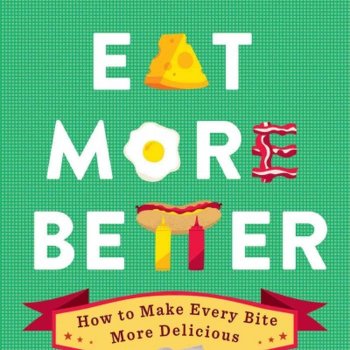On his beloved food podcast The Sporkful, Dan Pashman offers advice to listeners on how to maximize every eating opportunity. This week, he helps listeners minimize the amount of time they spend being impolite.

Rico Gagliano: Dan, welcome.
Dan Pashman: Hey, guys — thanks!
Rico Gagliano: So your book is full of these very funny, kind of faux-scientific but actually legitimately practical techniques. Let’s take one example of this: “The Pork Lift.” What is The Pork Lift?
Dan Pashman: Oh, yeah. All right, lemme ask you guys: You’re gonna eat a giant stack of pancakes. You pour syrup over your pancakes. And, granted, we probably agree that —
Rico Gagliano: …That’s awesome.
Dan Pashman: — Yes, we agree that that’s awesome! And we probably agree that pancakes are already kind of a syrup-delivery system. But the bottom pancake sits in the syrup, and what happens?
Brendan Francis Newnam: Soggy.
Rico Gagliano: It gets soggy with delicious maple syrup. What’s the problem here?
Dan Pashman: Don’t you think there’s such a thing as too soggy?
Rico Gagliano: Well… let’s go with your argument, that this is somehow a bad thing.
Brendan Francis Newnam: This could be a problem for some.
Dan Pashman: I mean, if you don’t think a pancake can ever get too soggy with maple syrup, you might as well just drink maple syrup.
So, the pork lift, basically: You build a bacon lattice structure with a couple of sides of bacon, and then you put the pancake stack on top of the lattice. That elevates the bottom pancake, so it doesn’t sit in syrup.
Brendan Francis Newnam: But you’re going to mess up your pancake-to-bacon bite-ratio.
Dan Pashman: How so?
Brendan Francis Newnam: Well, for a lattice, I’m assuming you need at least four slices of bacon. And then you’re trying to get that bite ratio with the crunch, the bacon, the maple syrup, and the pancakes. If you’re just giving away four of your bacons off the top…
Dan Pashman: I have a response to that, Brendan, which is:
Any time you fork any type of bite, be very cognizant of what ends up on the tip of the fork, because that is what will land on your tongue, and that flavor will be accentuated.So you have the bacon on the bottom of the stack of pancakes… You cut a bite… You stab your fork straight down… You have a perfectly designed bite right there.
Brendan Francis Newnam: Ahh! I like that.
Dan Pashman: The bacon is on the tip of the fork and the bacon has already been imbued with maple-based deliciousness. You don’t want to argue against that, do you?
Brendan Francis Newnam: That won’t compromise the integrity of the pork lift?
Rico Gagliano: Oh, good point. It could all collapse.
Dan Pashman: It will not. I have worked on this. I have done the work.
Brendan Francis Newnam: All right, look, so you obviously are a teacher of all things food, and there is actually a chapter in your book about etiquette. Are you ready to answer our listeners’ etiquette questions?
Dan Pashman: I’m ready.
Statute of Snacking Limitations
Brendan Francis Newnam: Our first question comes from Zigis in New York City. Zigis asks:
“What’s the etiquette for eating the last piece of bread, or an appetizer that comes in an odd number?”
Dan Pashman: This is a good question. I would say that, if you’re in a situation where everyone has gotten an equal number and now there’s just one left, then it’s every man or woman for themselves.
Rico Gagliano: You just dive for it?
Dan Pashman: Yeah. Just go for it. But let’s say you’ve gotten three, and everyone else has gotten two, and now there’s only one left. I think you should give other people a chance.
Brendan Francis Newnam: I’m with you.
Dan Pashman: But I think there’s a statute of limitations.
Let’s say it’s an appetizer that involves melted cheese. As it sits there, the cheese is cooling and congealing and it’s not as melty. It is losing deliciousness before your very eyes. I think it’s rude to let a food sit before you and diminish in deliciousness if that can be avoided.
Brendan Francis Newnam: That’s an insult to everyone.
Exploring the Culinary World Beyond French Fries
Rico Gagliano: So, Zigis, dive on it before it goes to waste. Here’s something from Jenny in Portland. Jenny writes:
“My boyfriend is vegan and when we are picking a restaurant, he will often say ‘Don’t worry about me, I can just have fries.’ I never take him up on this, and I only go to places which have vegan-friendly dishes… but which are not vegetable-centric, because he’s not that into vegetables. That really limits my culinary exploration of Portland. Should I take him up on his offer and just have him eat fries?”
Brendan Francis Newnam: I know these kinds of vegans.
Dan Pashman: I would say sometimes yes, sometimes no. I mean, I don’t think you constantly want to have him eating fries.
Rico Gagliano: Because he’ll die.
Dan Pashman: Right. But I also don’t think Jenny should feel guilty about, on occasion, being like, “I heard there’s this great restaurant. I’m going to bring my boyfriend and he’s gonna eat fries.”
Brendan Francis Newnam: Yeah, and think about it. Like, not so long ago, when you decided to be a vegetarian – I’m thinking of my friends in high school – you pretty much just ate French fries at a diner. Especially if he doesn’t like vegetables, I’m guessing he probably likes French fries.
Rico Gagliano: But what does he eat? Is it basically like seitan and soy products? And rice? That’s all he eats?
Brendan Francis Newnam: French fries.
Dan Pashman: There are a lot of good vegan baked goods. That’s actually, I think, the arena where vegan foods have most advanced. But unless he’s just sitting there eating cake all day… This guy sounds like the unhealthiest vegan I’ve ever heard of.
Brendan Francis Newnam: He doesn’t just need Vitamin D, he needs Vitamins A, B, C…
Rico Gagliano: A whole alphabet of pills.
Sneaking Sugary Contraband Around the Kids
Brendan Francis Newnam: So there you go, Jenny. Indulge yourself once in a while.
This next question comes from J.R. in LA. J.R. writes:
“My friend’s son, a curious three year old, has barely tasted sugar. His parents don’t want him to be lost to the dark side of overindulgence in sweets. Here’s the thing: Can I eat my beloved Halloween candy in his presence?”
Dan Pashman: That’s a tough one.
It’s harder when it’s someone else’s kid. When it’s your kid, it’s up to you to screw them up as you like.I’m a parent. I have a four year old and a one and a half year old. And, I actually talked about this on an episode of The Sporkful a while back with Hillary Frank, she does a great parenting podcast called The Longest Shortest Time. She talked about, like, sneaking animal crackers in the next room when her daughter isn’t looking. And her daughter is, like, “I hear a crunch-crunch sound! What is that?”
Rico Gagliano: In the 1960s this would have been marijuana, now parents’re sneaking animal crackers.
Dan Pashman: How the mighty have fallen.
Look, I don’t think J.R. should be prohibited from eating candy in this child’s presence, especially if they are around each other frequently. If it’s once a month, and you see this kid for an hour, then I think you can go an hour without eating candy.
Brendan Francis Newnam: That’s what I’m worried about! J.R., you’re an adult and you have to eat Halloween candy in front of a kid?
Dan Pashman: Well, I did a whole episode about trick or treating for adults one time, and I actually had a woman who told me that half the reason she had kids was that she would have an excuse to go trick or treating.
Rico Gagliano: Oh, man. That’s a long road to hoe for a bag of Snickers.
Dan Pashman: I dunno; it tastes better when you’re taking it out of your kid’s bag of candy, I do have to say.
Politely Not Sharing?
Rico Gagliano: So, there you go, J.R. Here’s something from Amy in Virginia. Amy writes:
“I have a special recipe that was handed down to me by my mother. I often make the recipe and give the dish to people as a gift. I am often asked for the recipe, but I don’t want to share it. Can I refuse but still be considered a well-behaved human being?”
Dan Pashman: Yeah… I would have to say it’s really wrong not to share the recipe. You would need to have an awfully good reason.
I ran into this a bit with my book. There’s a recipe for a thing called Drunken Salami, which is salami that marinates for weeks in Scotch and Russian dressing…
Brendan Francis Newnam: Sounds like a complicated recipe! Wow, are you sure you want to share that with everyone, Dan?!
Rico Gagliano: Also, how did you reach directly into my dreams to create a dish?! That sounds amazing.
Dan Pashman: It is really, really good. It was created by a gentleman who I had never met. He passed away years ago. It was his daughter who taught my friend who taught me the recipe. And so, I sort of had to tip-toe a little bit around this, because it was this gentleman’s legacy since he has passed on — people still make this dish and talk about him at special occasions.
If you have a specific situation like this… Or… I don’t know what your fear is: That someone is going to mess it up and then tell their friends that it was your recipe?
Rico Gagliano: Well, because she likes giving it as a gift! She wants to be special for having it.
Brendan Francis Newnam: Yeah! Aren’t we in danger of eliminating the little special-ness that is an important attribute to deliciousness?
Dan Pashman: Honestly I think, if it’s that good, and you’ve been making it for that long, they’re never going to make it as well as you do. But I think that if Amy wants a convenient excuse? Blame a dead relative. Just be, like, “On my grandmother’s deathbed, she told me never to share this recipe.”
Brendan Francis Newnam: Blame the dead.
Rico Gagliano: That’s polite.
Brendan Francis Newnam: Dan Pashman, that’s what we were looking for. Thank you so much for telling our audience how to behave.


